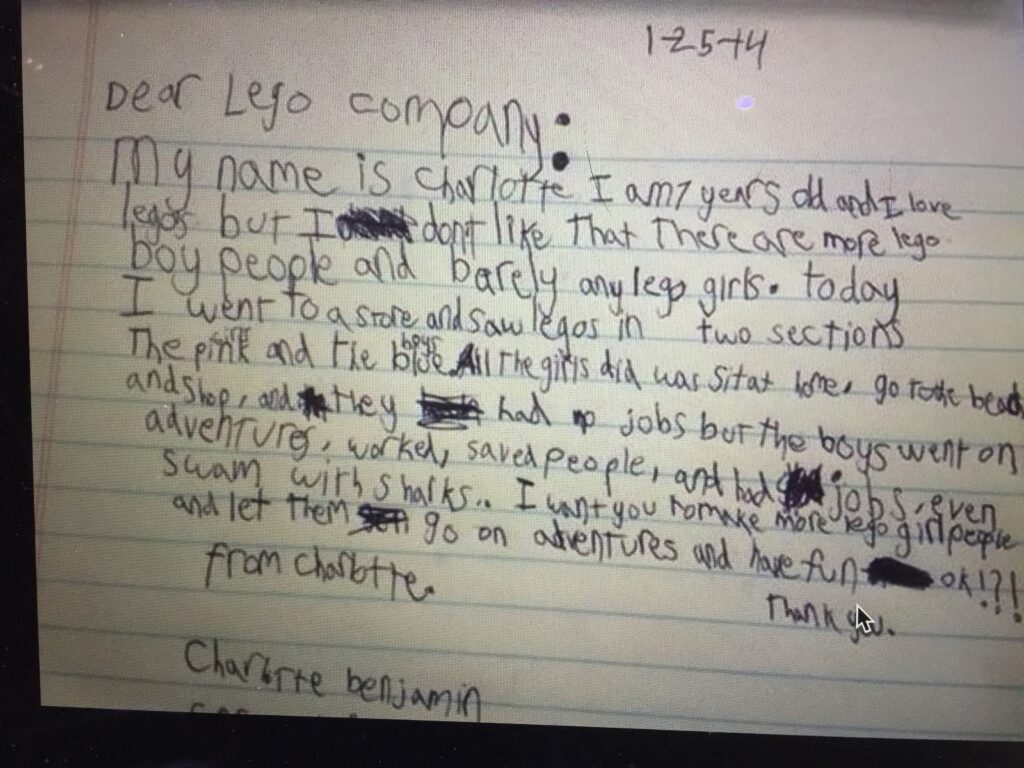
Seven years ago Charlotte Benjamin wrote a hand printed letter to the Lego company talking about her visit to the local toy store. Charlotte was seven years old at the time.
As reported by Kashmira Gander in the Independent, she wanted to know why the boy lego figures “went on adventures, worked, saved people and had jobs” while the girls “go to the beach, shop, and have no jobs.
Miss Charlotte also noted that the boys got to swim with sharks.
The toy maker have been criticised for producing gender specific lego people that go and gender specific jobs. Miss Charlotte had ended her letter asking the Lego company to “make more Lego girl people and let them go on adventures and have fun ok? Thank you.”
But here is what is interesting~Lego was introduced in 1934 and was branded as a toy for boys and girls. “Lego” means to “play well” in Danish and “I assemble’ in Latin.
This paper called ” L.E.G.O.: Leave Everyone’s Gender Out” by Krissy Baker and Marta Vucci says the Lego brand “was constructed with an inclusive, accepting name and message, but today it has fallen into the same pattern of gendered marketing that most toys seem to be following. However, in 1981, Lego put out an advertisement supporting the view that their toy promotes an activity that everyone can enjoy. “
This emphasis became important as more universal toys were sought that could teach STEM (science, technology, engineering and math) subjects and building for both boys and girls. There was a push in Great Britain to support toys that taught science.
In 2012 the Lego Company created Lego Friends, which further differentiated lego for girls and boys. Lego friends had five girl figures (no boys) and the activities were very specifically for girls, like a day at the hairdresser, cooking at the cafe, or helping out at the animal hospital. There was also not a lot of construction or building blocks with the Lego Friends. Most of the gear was prefabricated.
Unbelievably Poul Schou, a Lego’s vice president was interviewed at The Register,” a British technology news site. In his statement Mr. Schou stated that “Lego was for boys, not girls, because once the girls hit five, they weren’t interested in construction anymore.”
Those tables have turned as the demand by both girls and boys for lego blocks increased. Miss Charlotte’s letter had started a change in Lego’s offerings in 2013 they started a science series of mini figures that were girls. Those figures included girl aerospace engineers, shuttle astronauts, race car drivers, pit crew members, dune buggy operators and deep sea submariners.

Lego’s own research found that both boys and girls liked the building blocks, but girls wanted to build complete environments and streets while boys wanted to construct single structures. All children wanted to have a mix of boy and girl figures in the mini figures, and that has been a very successful line for Lego to market to all kids.
And you can see in the video below how girl specific the 2012 Lego Friends release actually was, staged in “beautiful Heartlake City”.












